Charnel Houses of Europe: The Shoah by MonsieurChoc

Introductions
Original SA post Charnel Houses of Europe The ShoahPart 1: Introductions
This isn’t an easy book to read or talk about, but I’m going to try. Published in 1997, Charnel Houses was developed by Richard Dansky and written by Jonathan Blake and Robert Hatch for the Black Dog Factory imprint. Most Black Dog books are closer to Cthulhutech than Shindler’s List, being mostly juvenile stuff with lots of sex and violence, but this book is actually a mature take on a difficult subject. The authors really did a good job, or as best as possible when writing a RPG book about the Holocaust.
Foreword
Mi Yagid Labanim: Who will tell the children?
By Janet Berliner
The book starts by an essay written by an author who, at the time, was about to publish the last book in a trilogy of novels dealing with the Holocaust. Here, she tells the story of all the memories she thought of when Rich Dansky called her about the project, and of what went through her mind before she answered him. She remembered a photograph of her grandmother and her siblings, three of which were deported to the camps. She remembered her uncle, who would speak while constantly switching between 6 languages, an old habit that was used to make sure the guards wouldn’t understand what you were saying. She remembered the Children’s Memorial at Yad Vashem, a memorial to the 1,5 million children who died during the Holocaust. Ultimately, her message is this: we must remember the horros of the past, to hopefully prevent them from happening again. This is a theme that is very present throughout the book, the back cover writes in big letters “Because the Story Must Be Told” and it’s repeated again in the introduction.
Ghost Story: Rusalka
By Robert Hatch
This is the classic White Wolf short story at the start of the book. It’s only two pages long, and starts with a quote from “The Song of the Murdered Jewish People”, a poem by Yitzhak Kacenelson , who died at Auschwitz in 1944. The story itself is the charming tale of a woman who died in the gas chambers of Auschwitz and now takes her revenge on the granddaughter of one of the German doctors who was there. It’s short, brutal, and effective at setting the tone.
Introduction
We now come to the introduction proper. It starts with the usual description of what is in the book, before dealing with the controversial nature of the book. It is stressed that everything dealing with real world history was researched, and only the stuff dealing with the World of Darkness was added. The Holocaust wasn’t some weird plan of some occult faction, it was a human work, just like in the real world. The book is more interested in looking at the consequences of the Holocaust on Wraiths than in shifting blame, a position that I find myself agreeing with.
Charnel Houses of Europe posted:
Wraith is about unfinished business and passion, and surely the 12 million souls who died in the events of the Shoah had much that they left unfinished.
I think I’m going to stop here for now. Not much for a first post, but the next chapter is pretty big.
Next time: The Telling of Agonies.
The Telling of Agonies: A Chronicle of the Millions
Original SA post Part 2The Telling of Agonies: A Chronicle of the Millions
By Jonathan Blacke
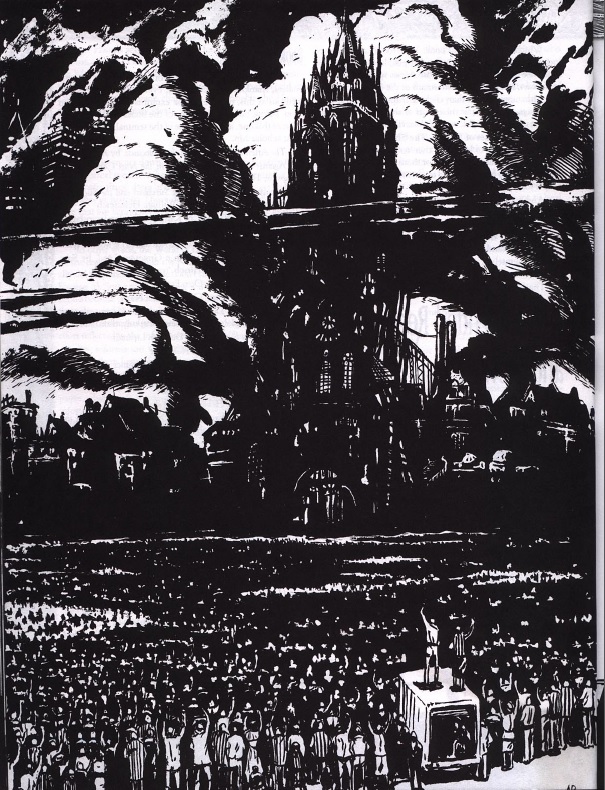
”Charnel Houses” posted:
You would tell the truth… And you know what would happen?... They wouldn’t believe you. They’d say you were crazy. Might even put you in a madhouse. How can anyone believe this terrible business – unless he has lived through it?
- Quoted by an SS Corporal to prisoner Simon Wiesenthal, near Lwow, Poland, 1944.
So, this is the history chapter. It tells in detail the history of the Holocaust, from Hitler taking power to the Allies liberating the survivors of the Death Camps. It goes over a lot of things, like the Evian Conference , the Krystallnacht , Operation T4 and all the other nice things the Nazis did. I’m not really going to over that, it’s a pretty good history and it really made me alternatingly sick and angry and sad. Instead I’m going to focus more on the sidebars that can be read throughout the chapter dealing with the effects on the World of Darkness. It was decided, wisely, to separate the fiction from the facts in this section, so that no one could mistake one for the other.
Note: There’s going to be a lot of Wraith jargon thrown around, so it might be a good idea to reread the old Wraith corebook review in the first thread.
Hidden Agendas: While the various Supernaturals were not the cause of the Holocaust and were not leaders in the Nazi party, they were still involved in some ways. In this Sidebar, it’s revealed that the early Thule Society had many Verbena members, while the Technocracy, especially the progenitors and Iteration X, had close ties to the Nazi regime. If those names don’t mean anything to you, don’t worry, this is Mage stuff. The Sons of Tertullian, a group of extreme exorcists know for burning down orphanages rather than let ghosts live in them, were also involved in the Nazi government, albeit at the lower levels. They used the Nuremberg laws to persecute Gypsies, believing them to be mediums, and many of “Gypsies” were imprisoned in concentration camps and had forced “exorcism” performed on them. Few survived.
Taking Sides: During World War II, many group saw themselves torn apart, divided along national lines. This is especially true of Mages, with the Technocracy falling into literal civil war over it. Meanwhile, in the Underworld, Charon and the Hierarchy were at war against the Dark Kingdom of Jade, and every resource Stygia could muster were used for the war. Reapers, the people in charge of processing new wraiths and decide whether to enslave them or soulforge them (Wraith is such a cheerful setting, isn’t it?) suffered tremendous overwork due to the war, and took a lot of short-cuts to deal with it, such as getting unofficial apprentices. The early Holocaust wraiths were therefore lost in the bureaucratic mess for a while.
The Partition Accords: Eventually, the Hierarchy started noticing what was going on. Nihils, holes in the underworld leading to the Labyrinth, started appearing in places that had been stable before. And then strange wraiths, with never before seen Deathmarks, started showing up. They were refused entrance in many Necropolises, as they looked strange and ragged, others feared they might be a new breed of spectre, and some simply had not let go of their living prejudices and so wanted nothing to do with these undesirables. Eventually, a group of representatives of the new Shoah wraith reached Stygia, accompanied by the mysterious Ferrymen, and demanded an audience with Charon. They got it. There, they revealed what was happening in the lands of the living. Charon and the Deathlords were stunned, but not because they cared about the Shoah wraiths. This was dangerous for the state of the Shadowlands, as it could cause all kinds of Spectre nastiness to come into being. With Charon busy with his war against Yu Huang, the Deathlords drafted what was called the Partition Accords: the new wraiths would be placed in gated communities, protected by the Equitaes (knights of the Hierarchy) until they could adapt to life in the shadowlands and integrate with the rest of the Hierarchy over time. To the surprise of no one with half a brain, the ghost ghettos were a complete failure.
Project Werewolf: Not just humans were used in the Nazis’ experiments, some of the supernaturals were caught along with the communities they had been hiding in. Some werewolves and a few vampires were found and experimented upon by people like Mengele, to horrifying results. Most died. Some vampires also found the camps to be nice feeding spots. The Nazis did not care if they found the desiccated corpse of a prisoner, as he was going to die later anyway. Man, vampires are dicks.
The Army of Fire: Many members of the various resistance groups who fought against the Nazis did not stop fighting after death. They regrouped and started calling themselves the Army of Fire and went around trying to find old comrades… and enemies. When they saw the ghettoes of the Partition Accords, they were enraged and convinced the wraiths living in them to leave and join them. The Hierarch administering let them do it, thinking something like ‘Good Riddance’.
When the atom bomb was dropped on Hiroshima, the Sixth Great Maelstrom (a giant reality storm covering the shadowlands around the world, full of specters and other fun stuff) started. Charon vanished, presumably destroyed, fighting a giant Malfean who attacked the City of Stygia. Now in charge, the Deathlords had to deal with the Shoah dead. Another conference was called, and this time everyone showed up. The Deathlords, the Ladies of Fate, important officials, the Ferrymen, representatives of the Holocaust wraiths and of the Army of Fire were all present. There, the victims accused the Hierarchy of failing them and of shirking its responsibilities. The Deathlords, unsure of their new power, accepted their faults and signed a new treaty, the Covenant of the Millions . Basically, it renounced all authority over the Millions, gave them the Haunts created by the death camps as territory and promised to hand over to them all Nazi wraiths they could find. In exchange, the leaders of the free camps had to deal with the Nihils and Spectres created by the holocaust.
The ghettos are linked through the old nazi railway system, blasted into the Shadowlands by allied bombardments. The railways are protected by remnants of the old Army of Fire, to stop poachers and slavers who would target their trains. As far as organization go, they’re pretty anarchic, usually going by the “one leader chosen by the population” method of rulership. They mostly focus on finding still missing wraiths of victims and family members, hunting down the ghost of nazi war criminals and trying to redeem victims who have become Spectre. Because of their self-ruling nature, they are largely not trusted by neighboring Necropolis and are treated as outsiders by many. Many of the higher-ups are angry that these wraiths who “should have been theirs” were given so much liberty, and would like to bring the “Dark Kingdom of Wire” back under the thumb of the hierarchy. Fortunately, they are not without allies, with many Renegade groups and lower-ranked bureaucrats of the Hierarchy sympathizing with their plea. Another important topic for them is memory: structures in the shadowlands are powered by memories of the living. In order to be safe, they want to make sure the living remember what happened at these sites, and they subtly help things like Holocaust museums and other projects.
In the remaining chapters, we’ll see in more details four of these free ghettoes.
Next: An Antechamber of the Damned.
An Antechamber of the Damned: The Theresienstadt Ghetto
Original SA post Part 3An Antechamber of the Damned: The Theresienstadt Ghetto
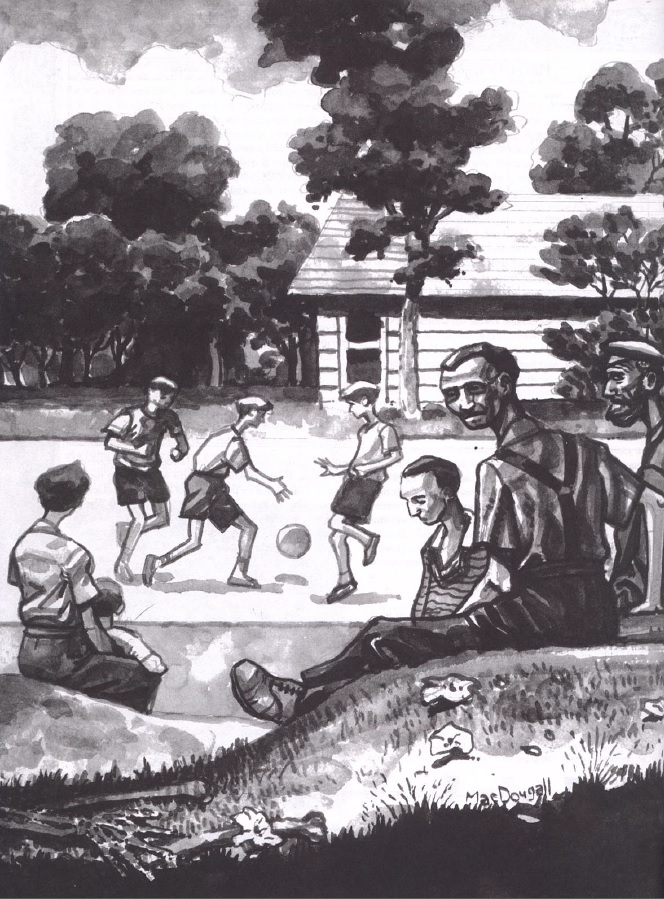
Wikipedia Article for people who want to be depressed.

In 1944, an International Red Cross delegation arrived at the Theresienstadt Ghetto, worried by the rumors of something horrible happening in central and eastern Europe. They went away satisfied that the rumors were unfounded: what they saw there was a perfect "model ghetto", with well-maintained streets, a flourishing artistic community, children playing in a park, with good food and all run competently by a council of Jewish Elders, the Judenrat . This was all, of course, a big lie. As soon as the Red Cross left, the living conditions became as terrible as they were before and it resumed it's true purpose: a waypoint on the railroad leading to Auschwitz, Dachau and other Death Camps. All in all, 35 000 died in the camp, due to disease, hunger and mistreatment. Of the 15 000 children who passed through Theresienstadt, only 100 survived.
What remains in the Shadowlands is a phantom copy of the camp, looking like a wound in the surrounding country, complete with bleeding walls. The wraiths who live there, calling themselves the Ghetto Circle, have decided to transform the place into a site of healing for the dead, not an easy task. The nearby Small Fortress, used by the SS for torture and execution, is the site of a Nihil, a hole in the Shadowland leading to the Tempest and serving as a gateway to the Spectres who live there. Thanks to the work of the Ghetto Circle, it is much smaller than before, but it remains a constant threat. Here's a map of the camp:
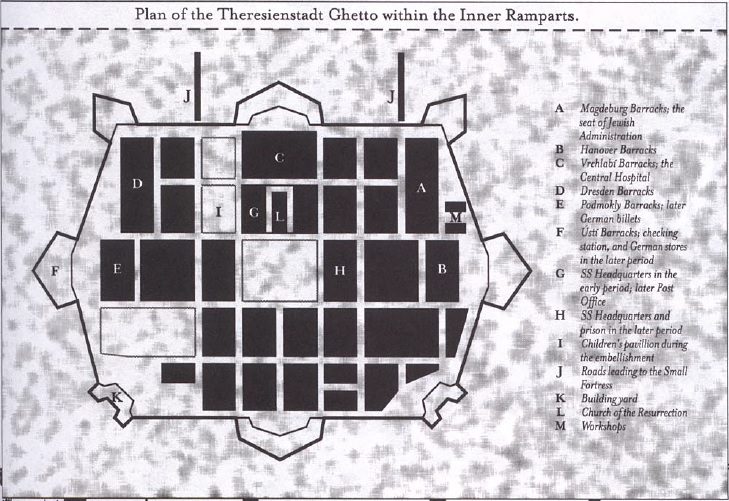
Town meetings take place in the Church. The Hospital house those who died of disease, with Doctor Holvenbach acting as their spokesperson, a responsibility he takes very seriously. The old Judenrat quarters host what passes for city administration. There's a few factions in the camp: the largest are the patients, led by Doctor Holvenbach. They often dictate policy because of that. Some resent the majority for their power,e specially since their leader is German. There is also fear of the Doctor's Redemption program, his still unsuccessful attempts to redeem people who became Spectres. The smallest and most hated group are the Red Cross wraith, members of the IRC who visited Theresienstadt and are now Fettered there. Their inability to see what was really happening has not be forgiven by many.
Some of the most important NPCs are described, with stat blocs. Butterfly is the ghost of a young street painter who died after her drawing of what was going on in the camps was discovered during the lead-up to the Red Cross visit. Her nickname came from the children living in the camp, for whom she would draw butterflies and other happy things. Now, she mostly stays silent, and draws constantly. She draws strange murals, sometimes hopeful, sometimes full of despair, reflecting her deep connection with the Haunt. Her passions include convincing people of her connection with the spirit of the camp and helping others with her drawings, as well as finding the children she used to watch over. Her Shadow, however, tells her no one cares about her "special connection" and wants to convince her she should sacrifice herself for the good of the camp. Solomon Eisenfeld is the leader of the camp, and a Rabbi who was on the Judenrat when alive. Sent to Theresienstadt because of his fiery sermons contesting the Nazi regime, he put in charge of selecting who would be sent east to the death camps. This job destroyed him inside, until he found himself deported in 1944. Now, he seeks to earn forgiveness and does his best to protect the ghetto wraiths, despite many still hating him for what he did. His Shadow, on the other hand, wants to rule with an iron fist and break the covenant with Stygia, as well as convince him that he is a horrible leader. Dr. Richard Holvenbach was a proud german, born during the Second Empire under Bismarck. His brother died during WWI and he found himself on the wrong side of the Versailles Treaty frontiers, but he never stopped hoping that the land would return to Germany. When it happened, he was initially quite happy and enrolled as an army Doctor. His whole world crashed when he was affected as camp doctor to Theresienstadt. Seeing the horrors perpetrated by his countrymen, he did his best for the prisoners of the camp, even trying to talk to one of the Red Cross diplomat who did not believe him, until he died of cholera in 1944. He now represents a large group of wraiths who look up to him, remembering the good things he did in life, and leads the camp's Redemption program. His passions are to redeem Mortwights (wraiths who became spectre instantly upon reaching the Shadowlands) and represent his constituents. His Shadow passions are to sabotage the Redemption Program and sow dissension within the Ghetto Circle. Jean-Claude Leclerc is the Red Cross diplomat who didn't believe Dr. Holvenbach. Such horrors could not be possible! He died in 1947 of intense alcoholism, and joined the Ghetto Circle soon afterward. His passions are to Gain acceptance in the Ghetto, find the SS who lied to him and get even, and to help his fellow IRC wraith. His Shadow Passions are to Find the SS ghost and lead them to the camp, discredit Holvenbach and bring Spectre into the Ghetto. Aaron Dahlcek was one of the carpenters who originally built the camp, lured there by the false promises of the "model ghetto". That illusion did not last long, and he soon saw the camp he had helped build become a house of horrors. He died during an escape attempts, two weeks after the Red Cross visit. While he hates the camp for the memories it brings, he is helped by the friednship he has formed with Butterfly. His passions are to protect Butterfly and help Holvenbach with the Redemption program. His Shadow wants to abandon Butterfly and to convince Aaron that by helping build the camp he is responsible for what happened in it.
The chapter ends with three story ideas:
- The characters are part of an attempted redemption of a Mortwright that goes horribly wrong, causing the subject's destruction. They are now accused of sabotage, and must clear their name by finding out what went wrong.
- Eisenfeld tells the characters of his suspicion that there is a mole in the camp working with SS ghosts. He cannot help the players in their investigation, however, as suspicions about his dealings with the Stygian representative are on the rise.
- The situation blows up between holvenbach and Leclerc, causing the Red Cross wraiths to leave. Eisenberg and Dahlcek are worried they might do something self-destructive and send the characters to find them, but even if they do they must deal with holvenbach and Leclerc... and their Shadows.
Next: Behind the Wall
Behind the Wall: The Ghetto at Warszawa
Original SA post Part 3Behind the Wall: The Ghetto at Warszawa
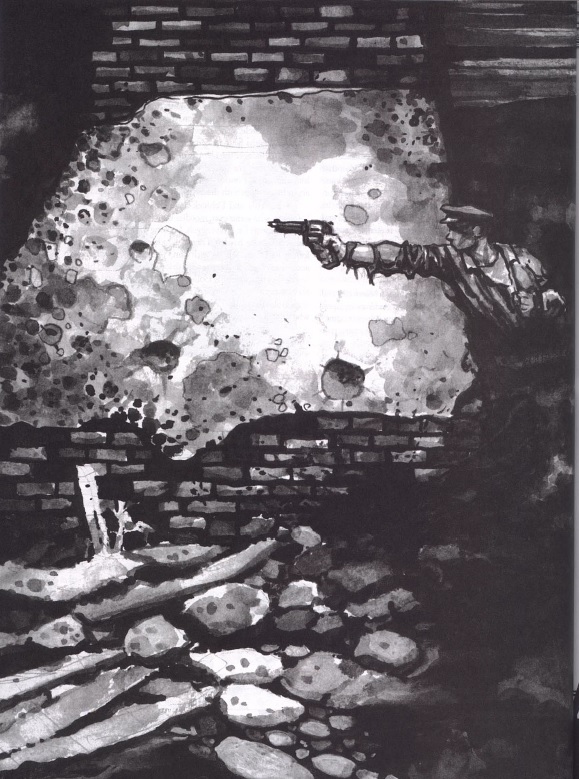
The Warsaw Ghetto is one of the most well-known locations of the Holocaust, along with Auschwitz. If you've seen Schindler's List, The Pianist or many other movies you've seen the Warsaw ghetto. After the Nazis conquered Poland and took over Warsaw, they corralled all the Jews into a small and poor neighborhood and then built a wall around it. Life in the ghetto was pretty terrible, with the authorities treating the inhabitants terribly and resources being terribly lacking. The author can't help but notice that the Snickers bar he was eating while writing this chapter contains more calories than the average inhabitant of the Ghetto would get in an entire day.

Once again the Nazi set up a Judenrat to serve as their puppet government, as well as a Jewish Police Force made up of people who had little contact with the Jewish community previously. They were apparently sometimes worse than even the SS. Adam Czerniakow , the leader of the Judenrat, choose to cooperate with the Nazis as much as possible, but eventually killed hismelf in 1942 when he found out what deportation really meant. It changed nothing. Meanwhile, a resistance was being formed in the Ghetto. Helped by a member of the Polish Communist Party, Pinkus Kartin , partisan's were trained and started planning attacks. While he was soon executed by the SS, he did meet up with a young man by the name of Mordechai Anielewicz who ended up becoming a leader of the Ghetto Resistance. Despite the lack of help from other Polish resistance groups, who were pretty anti-semite themselves, he started storing weapons and ressources. They slowly turned the ghetto into a veritable deathtrap, full of traps and secret tunnels and bunkers. And when in early 1943 the Nazis decided to completely empty the Ghetto in preparation for the Final Solution, the Jew fought back.
Charnel House posted:
Mein Gott! Die Juben haben Waffen! (My God! The Jew have weapons!)
- screamed by the first Nazi soldier to die in the Ghetto Revolt
For 27 days, the various Resistance groups fought back in Ghetto Uprising . Armed with Molotov Cocktails, smuggled guns, artisanal explosives and whatever they could get their hands on, they held the Wermacht at bay for more days than it took to conquer Poland in the first place. Eventually, the german commander Jurgen Stroop won, but only by burning the entire Ghetto to the ground. The entire neighborhood was razed block by block, with the few survivors sent to the Death camps.
In the Skinlands, almost nothing remains of the ghetto, except for a few monuments and small museums. However, in the Shadowlands the place remains almost entirely intact, sent there due to the German destruction. The dead remain segregated in death as they were in life, with the Dybbuks of the Ghetto rarely meeting with the Polish ghosts of the rest of Warsaw. While not all Jewish dead became Wraiths, it is estimated that as many as 20000 wraiths live in the Ghetto. There's a lot of factions among them, the most numerous being the ghosts of the partisans, still lead by Anielewicz. While the Hierarchy considers them to be Renegades, their popularity and the Covenant renders them untouchable for now.
The Ghetto is now protected by the Wall that closed it in the lands of the living. Huge and oppressive, it offers protection against the Spectre that try to attack the Ghetto... as well as the eternal prison of Nazis who found themselves on the wrong side of the wall in the afterlife. The Sewers under the Ghetto are still there, patrolled to keep an eye out for Spectres who might invade from the Labyrinth. The Central ghetto is where the Judenrat used to be housed, and now houses the new leadership of the Ghetto. It also houses a few monuments in the Skinlands, serving as springs of Pathos to the wraiths. The Productive Ghetto was where the factories were, and in death the factories are still there, working for the Jews this time. This is where things are soulforged or moliated into tools, and due to the lack of raw materials a thriving Black Market is also present. Finally the Wild ghetto, what used to the poorest and most destroyed area of the living Ghetto, is now a lawless mess were most Dybbuks fear to go. It might house Spectres, and it's "leader" might or might not be the ghost of Moishe the Bolshevik, a man who helped Anielewicz during the Uprising.
We now get to the important NPCs of the Ghetto. First up is Mordechai Anielewicz : after leading the Uprising, the young man did not let something as trifle as death stop him. He's now the leader of the Ghetto wraiths, and is something of a legend among Europe's wraiths. His stats are suitably impressive, wit multiple Attributes and Arcanoi at 4 or 5. His Passions are to keep protecting the living and dead Jews of Warsaw and to never let a fascist regime threaten his people again, while his Dark Passions are to give up the good fight, betray the people and avenge himself against the ingrates. Emily Landau was the first to kill a Nazi during the Uprising, and the first Jew to die. She's one of Anielewicz's top aide, but has developed unrequited romantic feelings for the leader. This has had the unfortunate side-effect of strengthening her Shadow, as the dead 17-years old teenager does not know how to deal with her emotions properly. Her Passions are to make Anielewicz fall for her, avenge herself and protect the surviving Jews of Warsaw, while her Dark Passions are to make Mordechai care (associated with codependency instead of love) and to "avenge" herself on anyone who pisses her off. Adam Czerniakow is the old leader of the Judenrat. He spent many years wandering aimlessly through the Ghetto until Anielewicz gave him a minor diplomatic position out of pity. Czerniakow hates him because of this pity and mercy. And it seems his Shadow has used his diplomatic position to enter into contact with dangerous Dead... His passiosn are to redeem his "good" name, atone for the deaths of the deported ones and to keep the community safe, while his Dark Passions are to get Anielewicz killed and to force the Warsaw wraiths to show gratitude for all he has accomplished. Rebbe Zishe Friedman was an advocate of nonviolence in lfie, which led to him being beaten to death by an SS officer. Now, he's become a sort of religious leader in the local dead's search for Transcendence. His Passions are to preserve the Judaic faith beyond the shroud, teach "truth" to all listeners and to abstain from militancy, while his Shadow Passions are to study occult lore without caring for the consequences and tot rick people into avenging his death.
The chapter ends once again with story ideas:
- The Warsaw wraiths become involved in the politics of newly democratized Poland, violating the Dictum Mortuum. The player's are dispatched to patch things up... or exploit them for their own ends.
- Anielewicz makes a daring raid into the local Hierarchy Citadel, stealing a powerful Artifact, and the characters are sent to retrieve it. But was it really him who did it? And if it was, with whom the characters will ultimately side?
- Rebbe Friedman (or his Shadow) contacts a Spectral hive, allowing them into the Ghetto. A harrowing game of Cat and Mouse ensues in the Wild Ghetto.
Next: A Struggle for the Forsaken
A Struggle for the Forsaken: Babi Yar
Original SA post
If I want to do a different book eventually, I should get down and finish this own. So here we go, only two chapters to go.
Charnel Houses of Europe Part 4:
A Struggle for the Forsaken: Babi Yar
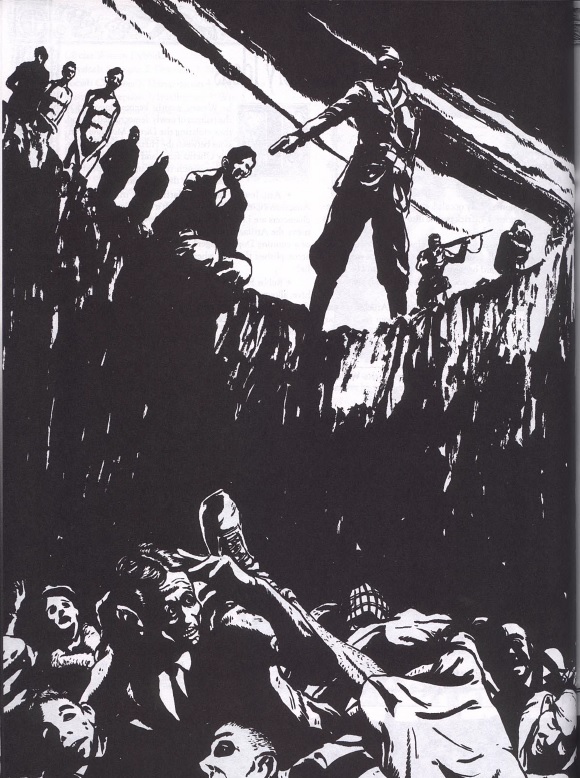
http://en.wikipedia.org/wiki/Babi_Yar
Unlike the other chapters, Babi Yar wasn't the site of a Concentration Camp. It was a death pit. As the German army marching through Russia advanced, they reached Kiev. A few days after the city fell, in September 1941, NKVD saboteurs blew up the new local SS headquarter. In retaliation, the Nazis decided to kill all the Jews in town. They marched every Jewish person they could find, marched them to the nearby Babi Yar ravine and then simply slaughtered them with machine guns. For the next 24 months, the Nazis kept using the ravine as their execution field. In 1943, as the Russian army was gaining terrain and they were soon to reclaim the city, the Nazis attempted to hide what they had done and had prisoners dig up the mass graves and cremate the hundreds of thousands of rotten corpses before having them grind them up and scatterred. Learning that they were to be executed afterward, 15 of the 25 prisoners managed to escape, with the remaining being the last victims of Babi Yar.
Yeah.

So, what went on the ghost side? Well, Babi Yar ravine is the site of a huge Nihil, a dangerous hole leading to the Labyrinth. For a while, the new wraiths were victims to the hordes of Spectres that would routinely get out of the ravine. Things changed when a group of former Red Army wraiths arrived to help, teeming up with the survivors to defend the new ghosts that kept showing up. Eventually, with the end of the war and the formation of the Covenant of the Millions, the Wraiths of Babi Yar organized themselves. The place is more like a way-station than a place where Wraiths live. The local wraiths are split into the two Circles: the
Menders
, made up of the dead of Babi Yar who try to find and help other survivors, as well as somehow heal the nearby Nihil, and the
Fallen Comrades
, who are mostly the Red Army soldiers who came back from the war and decided to protect nearby Wraiths from the horrors in the Ravine. Things have apparently been getting better in recent years (when the book was published, fifteen years ago or so) as the fall of communism has removed the official stance of ignorance of the massacre and so some healing has begun.
There's a sidebar which explains that the wraithly authorities of Kiev don't really like the Babi Yar wraiths and consider them something like lepers, due in part to their habit of throwing into the Nihil the wraiths of their murderers. There's also a really creepy statue formed apparently out of the remains of dead nazis and collaborators.
The chapter ends with NPCs and plot hooks, as usual.
Diana Ryachev
is one of the persons who died at Babi Yar. Her story is horrible. She's one of the menders now.
Nikolai Dimitrius
was a normal everyday policeman. When the Nazis had the Police help them kill all the Jews in Kiev, he couldn't take it and shot himself. He's now part of the Fallen Comrades.
Captain Alexander Renko
is the leader of the Fallen Comrades. Growing hearing stories of the glorious revolution against the Czar, he joined the war along with the other boys from Kiev wanting to be a hero. Instead he died. Having gathered the rest of the dead from his squad, he returned home only to find horrors waiting for him. He organized his troops to defend people from the Spectre, becoming a hero in death.
Marta Karinska
is a spectre, what remains of a bitter old woman who really hated the Jews, and can't let go of her hatred after death.
Melki Sornokov
was one of the prisoners who failed to escape at the end of Babi Yar. He really wasn't lucky. He part of the Menders now.
Sergei Pravdovich
was a journalist who was a witness to the events of Babi yar. For years, he fought in vain to try and get the communist government to recognize what happened in the ravine. He was eventually shipped to a gulag, where he died.
The story hooks:
- Nikolai wants the players characters help to find a woman he helped escape before his suicide, but Marta the spectre is sure to interfere.
- Diana asks the PCs to help her follow a lead that might lead to her parents in the Kiev Necropolis, but the Kievan wraiths are suspicious as they believe the Babi yar wraiths want to blow up the place.
- The ghost of Marta's kid is found, and debate begins on whether or not they should use the kid to draw out the old spectre. Which sides will the PCs choose?
I didn't go into as much details with the NPCs as before, because goddamn they're depressing. Reading them once was enough.
Next Time:
Fucking Auschwitz.

Behind the Wire: Oswiecim (Auschwitz-Birkenau)
Original SA post
So, it's been a while since I've continued my readthrough of what is possibly the most depressing roleplaying game book. Half of why is laziness, half is because I didn't want to feel super-sad, and half of it is I plain forgot. Anyway, hope you guys are ready, because this is the last chapter: fucking Auschwitz.

Charnel Houses of Europe Part The Last:
Behind the Wire: Oswiecim (Auschwitz-Birkenau)
by Robert Hatch
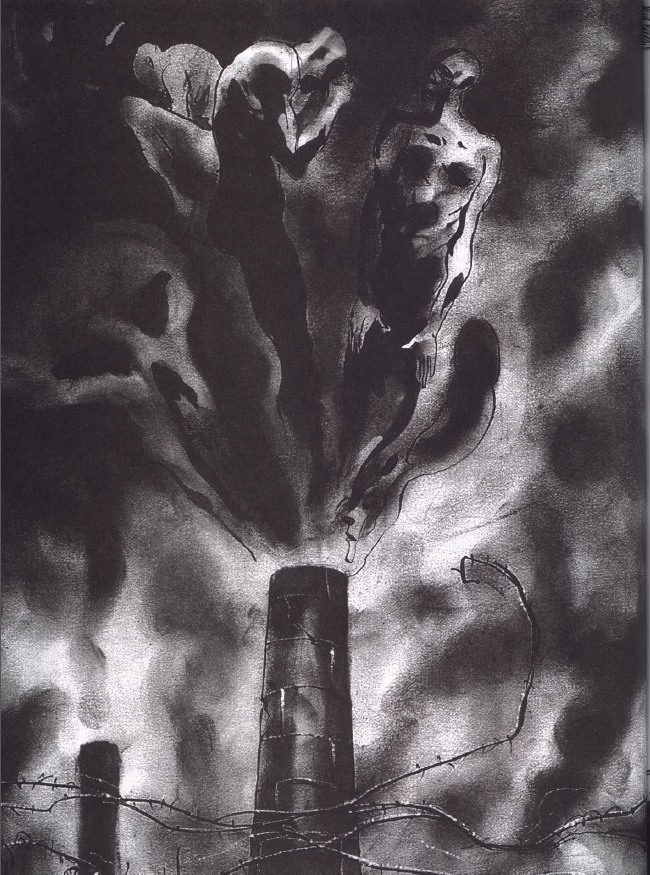
”Charnel Houses” posted:
We are told that the American soldier does not know what he is fighting for. Now, at least he will know what he is fighting against.
- General Dwight David Eisenhower, upon liberating the death camps
So, this is it. The last chapter, the big one: Auschwitz . The first words of the chapter are
“ARBEIT MACHT FREI
Work will make you free. ”
And it’s not going to stop from there. 2 million people were sent to Auschwitz, and few came back out. What they suffered through is pretty horrifying. And it had its effect on the land of the dead: Auschwitz is apparently the biggest Necropolis in Western Europe, and it’s not a very nice place.
After that brief description, we get a long section on the history of the place, aptly titled “A History of Hell”. I’m not going to go over the history of the real Auschwitz: a lot of people did that better than me. The first sidebar explains how the Deathlords of Stygia are scared of Auschwitz, due to its size and population. That many wraiths could pose a challenge to the fragmented Hierarchy, if they’re still wraiths that is… Another sidebar explain the “color” system that was in use in the place, with the color of the triangle sewn onto your uniform explaining why you’d been sent to the camps (red for political prisoners, green for normal criminals, etc.) Another sidebar talks of the Russian prisoners, their terrible treatment and horrible deaths, and of how they became Spectres in death, the few among them who had become normal wraith apparently having been destroyed by the rest. Their leader is said to call himself Koschei the Deathless, and to be particularly evil and terrifying. Later on, the Sonderkommando’s revolt is briefly retold, ending in their death. A further sidebar notes how, despite many groups in the World of Darkness claiming to protect the Gypsies, none of them lifted a finger to help the 20 000 who died at Auschwitz. Finally, the history of hell ends with the liberation of the camp by Soviet troops. The whole section was pretty damn depressing.

Next section is the Camp’s geography, first in the Skinlands and then in the Shadowlands. The camp has now become a museum, dedicated to the suffering of those who went through it. The parts of the camp not open to the public are slowly falling apart, rusting, crumbling. The museum is a huge source of Pathos for the wraiths of Auschwitz, often hoarded by the most powerful “for the good of the community”. Sometimes Spectres will scare the living who come to visit. A rather unfortunate passage mentions how there a lot of Drones (ghosts with no personality, simply repeating events of their lives and/or death) around and that they called Mussulmen by the locals. They’r emostly left alone.
Then we get the description of the “Dark Kingdom of Wire”, the Auschwitz Necropolis. The first thing to note about the place is the smell. It is apparently so terrible, visitors will take days to get rid of it. Next is the sound, a terrible dissonant cacophony (presumably someone is playing the Drakengard soundtrack on loop through the camp’s loudspeakers). Then is the giant cloud of human ashes that forever covers the camp, known as the Miasma. Sometimes it takes the appearance of Zyklon B! Then, finally, the camp itself, overshadowed by the four towers of the crematoriums. This is a happy place.

The well-known gates are still present in the Underworld, with the war criminals who used to run the camps visibly moliated into it. They appear to be in agony. Some have evaded the vengeance of the dead though. Plot Hook! The description of the camp if horrifying and not a little disgusting: for example, a mildew of rotting human flesh cakes the entire camp and returns when removed, so most inhabitants simply live in human filth. Barbed wire is everywhere, as well as serving as the camp’s boundaries. Yeah. Anyway, there is a giant Nihil called “Sheol” where the SS Barracks used to be, the center of oblivion within the camp. Guarding it is a duty no one wants to do, but everyone takes seriously: from time, it “erupts” and hordes of Spectres come forth to attack the camp. The giant Kremas are the center of industry, as they are where the Soulforges are situated. No one stays in them after dark, when their flames turn blue and screams can be heard coming out of them. There’s a bordello, called the House of Dolls, with strange and creepy entertainment and corridors that lead straight into the Labyrinth. It’s Madam was decapitated, and holds her skull in her hands. Birkenau is mostly haunted by Spectres, with wise Wraiths staying clear of it. The factory camp of Buna, a few kilometers away, is held by a group of communist Artificers called the Collective, led by an old agitator named Stefan Brukovich. They have a large forge where Nazis are sometimes soulforged. In recent years the camp has become more isolated from the rest of Aushwitz, as they are starting to fear the corruption spreading there. And there are many barely-organized subcamps spread around, often attacked by Spectres.
Society! Well, it’s a mess. There’s no leader, or even leaders. No census or identifications (reminds people too much of when Nazi ran things). Still, the Dybbuks of Auschwitz do gather in small groups, called Kommandos or Triangles in a display of bitter irony. We get a section on “deathmarks”, the signs of their deaths that wraiths display. It’s about what you’d expect of people who died at Auschwitz, that is to say really disturbing. Then there’s stuff on the most notable Triangles:
- The Partja : ghosts of socialists who still believe in social justice. They want to reform the camp into something better.
- The previously mentioned Colelctive: old-school communists with a monopoly on Darksteel goods.
- Die Eingeistein : A brutal gang made up of former Kapos . They signed an accord to serve as a conscripted militia in exchange of not being thrown into oblivion and grudgingly keep their word.
- Kanada : A group of pawnshop and relic-brokers. They sometimes kidnap people to sell to the soulforges. Nice guys!
- The Sonderkommandos: A lot of those guys are still around. They’re not well-liked, except for those who rebelled against the Nazis at the end.

Aside from that, the black triangles, those who were “Aryan” and better treated in life, have become known as “Shit-ghosts” in death and are the bottom-feeders of the camp. There are also large group of “Striplings”, spectre-children, wandering the camp. The pink triangles, homosexual, are pretty badly-treated by everyone, as most people died in the 40s, not exactly enlightened times. The Gypsies prefer wandering outside the camp, coming in to do work and when Spectres attack. They’re largely distruste,d because even today Europe is horribly racist to Gypsies. There’s also a few Jehovah’s Witnesses, who mostly keep to themselves and help people by acting as Pardoners.
Yeah, even in death, everything is

Then we get new merits and flaws, the first time new mechanics are introduced in the book. The first one, Tainted Humors , a 3-point flaw, transforms the Pathos you absorb into Angst when you fail a difficulty 5 willpower roll (all of it if you botch). While the roll isn’t hard, the consequences are terrible so I’d say it’s not worth it. The second one, Starving , a 4-point flaw, causes to look like an emaciated wreck, have only 8 health levels instead of 10, and when feeding on pathos you must make a difficulty 10 willpower to tear yourself away. Another one that seems really harsh and not worth it. And then there’s the Waffengeisten , Nazis moliated into being the Camp,s guard hounds. Their existence is suffering.
After all of this, we get the long list of NPCs that is in every chapter. I’ll only list the notable ones this time:
- Schlomo Ficzka , leader of the 12th Sonderkommando: a giant brute of a man, he’s the leader of the Sonderkommandos who rebelled against the Nazis. He serves as a guardian to the Camp, but his Shadow has become really strong.
- Rosa Robota , Polish jew and communist agitator. Brutally tortured and murdered for helping the Sonderkommandos’ revolt. She’s really angry.
- Joachim Steuben , a pimp and pusher and purveyor of horrible needs.
- Malina Prmystleskza , a doctor who helped others after she found herself in the camps. She performed many a “mercy-killing” on young babies so that they wouldn’t be experimented on by Mengele, and now sometimes help save babies by possessing their parents to perform the medical procedures needed. And sometimes when her Shadow takes over she harms them.
Finally, plot hooks. With the end of the Warsaw pact (this was the 90s after all), the players might try to help their descendants from beyond the grave, and act the hierarchy might frown upon. Another one has the PCs as heretics searching for Transcendence. Eventually, one of their followers eagerly attempting redemption is revealed by a group of angry Dybbuks to be one of the guards at Auschwitz. The last one has the PCs as Spectres, attacking Auschwitz.
Final Thoughts :
So, this is finally over. Despite being only 126 pages long, this book is really hard to finish, due to its pretty horrifying subject matter. It’s well-researched and does a good job of giving you an idea of what the horror was like, and the picture it draws of the afterlife is even worse. The writing quality varies greatly between chapters, the best one being the Warsaw Ghetto by far. I’d say it worth a read, but I’ll never use it for a game.